Friday, May 25, 2012
Saturday, May 19, 2012
Bob Kerr's 'Undercoat' blog: paintings of Waihi
Artist Bob Kerr has been working on some paintings for the Waihi Strike centennial. Have a peek at his blog here: http://undercoatblog.blogspot.co.nz/p/waihi-project_28.html.
Monday, May 14, 2012
100 years ago today: start of the Waihi Strike
On 14 May 1912 one of New Zealand's most bitter industrial disputes began in Waihi. By November, the New Zealand Police had flooded the town, a miner was batoned to death and families driven out of town by mobs of 'free' (scab) labour.
Background...
The New Zealand labour movement at that time was undergoing a deep radicalisation. Like their fellow-workers worldwide, New Zealand workers were discovering syndicalism, direct action and fostering a radical working class-counter culture of penny pamphlets, socialist 'Sunday schools' and streetside soapboxing. As a result, workers across New Zealand were increasingly questioning what was perceived to be a bankrupt system—arbitration.
In 1894, legislation was introduced that outlawed strike action and forced unions and employers into negotiated industrial awards governed by the Arbitration Court (known as the Industrial Conciliation and Arbitration Act, or ICA). Although the ICA had encouraged the growth of trade unions in New Zealand, “a complex interplay of changing work patterns, a rapidly expanding workforce and the bankruptcy of traditional union strategies” led to widespread dissatisfaction from around 1906 onwards.
The first to challenge arbitration was an illegal strike by 66 Auckland tramway workers in 1906 who, against the judgement of their union official, walked out in protest after a number of motor men had been dismissed. After ceasing work for half a day and smashing the company’s plate glass windows, management caved. This was followed in 1907 by a strike of slaughtermen—200 of who were fined for their illegal action but who simply refused to pay. These successes turned heads, but the “rebellion burst into the open” with a strike won by the Blackball Miners’ Union in 1908, whose defiance against fines and the authority of the presiding Judge openly flouted the Arbitration Court and the ICA itself.
The strike also resulted in a Miners Federation, which soon grew into the ‘Red’ Federation of Labour, whose preamble stated ‘the working class and the employing class having nothing in common’. The Red Feds encouraged class struggle free of ‘labour’s leg iron’: the ICA Act. Affiliated unions, including the miners of the Waihi Trade Union of Workers, began to de-register from the ICA.
So in May 1912 when 30 engine drivers in Waihi re-registered under the ICA (reportedly encouraged by the bosses), the union struck in protest. According to Stanley Roche, on Tuesday 14 May, Waihi came to a standstill.
From NZHitsory.net:
The local police inspector initially adopted a low-key response to the dispute, but he was overruled by the tough Police Commissioner John Cullen, who ordered extra forces to be sent to the town. In July William Massey's conservative Reform Party came to power. Enthusiastically backed by Cullen, Massey was determined to crush the 'enemies of order'.
Eventually about 80 police - 10% of the New Zealand Police Force - were deployed in the town. Leading strikers, including Evans, were arrested, and more than 60 were gaoled... The Red Fed leaders began to lose control of the strike as workers influenced by the radical American-based Industrial Workers of the World (IWW or 'Wobblies') demanded more militant action.
In October the company reopened the mines with non-union labour.
Things in Waihi became more hostile with the arrival of these Police. While the scabs grew more confident they were equally met by the women of Waihi, who were extremely active on the pickets—'following-up' scab labour and hurling insults, rocks and humour.
However the strike failed. Intense police repression and violence saw the balance of power shift to the bosses. During what became known as the ‘Black Week’ in November, the Miners’ Hall was stormed, striker Fred Evans was killed by a police baton to the head (becoming the first worker do die in an industrial dispute in New Zealand), and unionists and their families were driven out of town as police stood by.
100 years on...
This year marks the Centennial of the Waihi Strike and to draw attention to our working past, the Labour History Project (and others) have organised a weekend-long event in Waihi:
THE DRAFT PROGRAMME:
Friday 9 November, from 4.30 pm
Registration at Friendship Hall, School Rd, Waihi
Light refreshments, tea and coffee. Dinner and drinks available RSA Seddon St
Saturday 10 November 8.30am to 12.30 pm
Seminar papers at Waihi Memorial Hall, jointly with the
Australasian Mining History Association
Lunch, plus refreshments at Friendship Hall
Saturday 1.30 pm to 5pm
Seminar papers, plus issues and interests presentations at
Friendship Hall
Alternatively - field trips, workshops and exploring,
Saturday 5.30pm
Exhibition opening of paintings by Bob Kerr
Saturday 7.30pm
Dinner at RSA, followed by social, including the Waihi Oratorio written and directed by Paul Maunder.
Sunday 11 November 9am
Commemoration of death of Fred Evans
Roll call of Waihi miners, with their descendants.
This looks set to be an important and historic event. More information will be available as it comes to light.
Sources...
There are a number of books and online articles dealing with the Waihi Strike (listed below). I would recommend Chapter 19 from Richard Hill's, The Iron Hand in the Velvet Glove, which is a nice summary of events. Download it here (collated to print PDF zine).
Other sources include:
- Campbell, R.J. 'The role of the police in the Waihi strike:some new evidence'. Political Science 26, No2 (Dec. 1974): 34-40
- Papers Past (online papers from the period, including the Maoriland Worker)
- Holland, H. E. et al. The tragic story of the Waihi strike.
Wellington, 1913 (very light on the IWW) - Olssen, E. The Red Feds. Auckland, 1988
- Rainer, P. 'Company town: an industrial history of the Waihi Gold Mining Company Limited, 1887-1912'. MA thesis, University of Auckland, 1976
- Roche, S. Y. The red and the gold. Auckland, 1982 (highly readable, but does not mention the IWW at all).
- Moriarty-Patten, S. ‘A World to Win, a Hell to Lose: The Industrial Workers of the World in Early Twentieth Century New Zealand’, Thesis, Massey University, 2012 (excellent—and only—study focusing on the NZ IWW)
- Video: Black Tuesday and the 1912 Waihi Strike. Watch it here.
Wednesday, May 9, 2012
May Day: A Graphic History of Protest
I've just ordered my very own copy of a new book, May Day: A Graphic History of Protest, recently released by the Graphic History Collective. From the web:
May Day: A Graphic History of Protest traces the development of International Workers' Day, May 1st, against the ever-changing economic and political backdrop in Canada and across North America. Recognizing the importance of work and the historical struggles of workers to improve their lives, with a particular focus on the struggles of May 1st, the comic includes the reader as part of this history, and the story concludes that “We are all part of this historical struggle; it's our history and our future.”
If you liked Wobblies or Working, I'm sure this will be up your alley. Plus, purchasing it from this link, Union Communication Services means you’re buying from a unionized online bookseller—helping LabourStart in the process.
Looking forward to this one! How cool would an Aotearoa/New Zealand version be? I actually originally imagined Remains to Be Seen as a graphic novel, but then remembered I can't draw... alas.
Tuesday, May 8, 2012
Celebrate Peoples History CHCH: Pics
Some pictures of the Celebrate People's History Project, currently on show at the Upper Riccarton Library, Christchurch (NZ). Its going to be up for another week still, so if you haven't had a look you've still got a chance : )
Celebrate People's History
Monday April 16 - May 14, 2012
Open during normal library hours
- Monday - Friday 9:00 am - 8:00 pm
- Saturday & Sunday 10:00 am - 4:00 pm
Upper Riccarton Library (Young Adult Section)
71 Main South Road, Sockburn
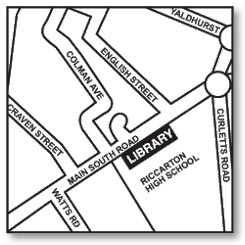
Friday, May 4, 2012
Wednesday, May 2, 2012
Wednesday, April 25, 2012
Dry hopping batch #4: APA

Thought I'd post a few pics of the process of dry hopping. This is for batch #4, which I'm calling an Addington Pale Ale (APA). Similar to batch #3, but with and increased amount of Cascade Hops instead.
So above, I've added my hop pallets to a plain, pre-bolied and sanitized pantyhose. There's about 1 oz in there, with the end of the pantyhose tied off at the very top to allow the hops to expand and dance. The pantyhose reduces the amount of sediment in the finished beer, and makes cleaning up easy.
I'm doing this 4 days into the fermentation process, and will leave it in there for 10 days. Removed the airlock, opened the lid, and had a wee peek. There's a bit of hop sludge from a few loose pallets I threw in on day one, but otherwise it's looking and smelling yum.
I dropped in the hops, and after taking these pics I gently submerged the hops with a sanitized spoon. Lid back on, airlock in, and now I'll leave it all for 10 days. The result: hopefully a very aromatic and flavorsome APA!
Friday, April 20, 2012
The importance of archives: British Government destroys records of colonial crimes
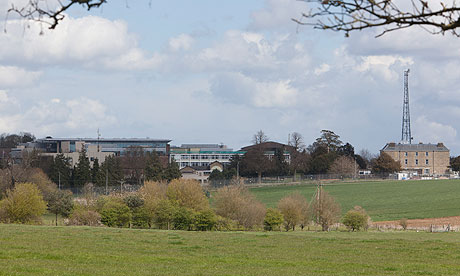
Hanslope Park, where the Foreign Office kept a secret archive of colonial papers. Photograph: Martin Argles for the Guardian
From the Guardian: Thousands of documents detailing some of the most shameful acts
and crimes committed during the final years of the British empire were
systematically destroyed to prevent them falling into the hands of
post-independence governments, an official review has concluded.
Those papers that survived the purge were flown discreetly to Britain where they were hidden for 50 years in a secret Foreign Office archive, beyond the reach of historians and members of the public, and in breach of legal obligations for them to be transferred into the public domain.
The archive came to light last year when a group of Kenyans detained and allegedly tortured during the Mau Mau rebellion won the right to sue the British government. The Foreign Office promised to release the 8,800 files from 37 former colonies held at the highly-secure government communications centre at Hanslope Park in Buckinghamshire.
The historian appointed to oversee the review and transfer, Tony Badger, master of Clare College, Cambridge, says the discovery of the archive put the Foreign Office in an "embarrassing, scandalous" position. "These documents should have been in the public archives in the 1980s," he said. "It's long overdue." The first of them are made available to the public on Wednesday at the National Archive at Kew, Surrey.
The papers at Hanslope Park include monthly intelligence reports on the "elimination" of the colonial authority's enemies in 1950s Malaya; records showing ministers in London were aware of the torture and murder of Mau Mau insurgents in Kenya, including a case of aman said to have been "roasted alive"; and papers detailing the lengths to which the UK went to forcibly remove islanders from Diego Garcia in the Indian Ocean.
However, among the documents are a handful which show that many of the most sensitive papers from Britain's late colonial era were not hidden away, but simply destroyed. These papers give the instructions for systematic destruction issued in 1961 after Iain Macleod, secretary of state for the colonies, directed that post-independence governments should not get any material that "might embarrass Her Majesty's government", that could "embarrass members of the police, military forces, public servants or others eg police informers", that might compromise intelligence sources, or that might "be used unethically by ministers in the successor government".
Among the documents that appear to have been destroyed were: records of the abuse of Mau Mau insurgents detained by British colonial authorities, who were tortured and sometimes murdered; reports that may have detailed the alleged massacre of 24 unarmed villagers in Malaya by soldiers of the Scots Guards in 1948; most of the sensitive documents kept by colonial authorities in Aden, where the army's Intelligence Corps operated a secret torture centre for several years in the 1960s; and every sensitive document kept by the authorities in British Guiana, a colony whose policies were heavily influenced by successive US governments and whose post-independence leader was toppled in a coup orchestrated by the CIA.
The documents that were not destroyed appear to have been kept secret not only to protect the UK's reputation, but to shield the government from litigation. If the small group of Mau Mau detainees are successful in their legal action, thousands more veterans are expected to follow.
It is a case that is being closely watched by former Eoka guerillas who were detained by the British in 1950s Cyprus, and possibly by many others who were imprisoned and interrogated between 1946 and 1967, as Britain fought a series of rearguard actions across its rapidly dimishing empire.
The documents show that colonial officials were instructed to separate those papers to be left in place after independence – usually known as "Legacy files" – from those that were to be selected for destruction or removal to the UK. In many colonies, these were described as watch files, and stamped with a red letter W.
The papers at Kew depict a period of mounting anxiety amid fears that some of the incriminating watch files might be leaked. Officials were warned that they would be prosecuted if they took any any paperwork home – and some were. As independence grew closer, large caches of files were removed from colonial ministries to governors' offices, where new safes were installed.
In Uganda, the process was codenamed Operation Legacy. In Kenya, a vetting process, described as "a thorough purge", was overseen by colonial Special Branch officers.
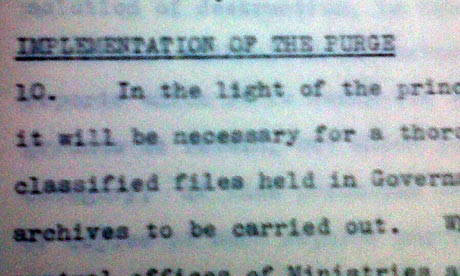
Those papers that survived the purge were flown discreetly to Britain where they were hidden for 50 years in a secret Foreign Office archive, beyond the reach of historians and members of the public, and in breach of legal obligations for them to be transferred into the public domain.
The archive came to light last year when a group of Kenyans detained and allegedly tortured during the Mau Mau rebellion won the right to sue the British government. The Foreign Office promised to release the 8,800 files from 37 former colonies held at the highly-secure government communications centre at Hanslope Park in Buckinghamshire.
The historian appointed to oversee the review and transfer, Tony Badger, master of Clare College, Cambridge, says the discovery of the archive put the Foreign Office in an "embarrassing, scandalous" position. "These documents should have been in the public archives in the 1980s," he said. "It's long overdue." The first of them are made available to the public on Wednesday at the National Archive at Kew, Surrey.
The papers at Hanslope Park include monthly intelligence reports on the "elimination" of the colonial authority's enemies in 1950s Malaya; records showing ministers in London were aware of the torture and murder of Mau Mau insurgents in Kenya, including a case of aman said to have been "roasted alive"; and papers detailing the lengths to which the UK went to forcibly remove islanders from Diego Garcia in the Indian Ocean.
However, among the documents are a handful which show that many of the most sensitive papers from Britain's late colonial era were not hidden away, but simply destroyed. These papers give the instructions for systematic destruction issued in 1961 after Iain Macleod, secretary of state for the colonies, directed that post-independence governments should not get any material that "might embarrass Her Majesty's government", that could "embarrass members of the police, military forces, public servants or others eg police informers", that might compromise intelligence sources, or that might "be used unethically by ministers in the successor government".
Among the documents that appear to have been destroyed were: records of the abuse of Mau Mau insurgents detained by British colonial authorities, who were tortured and sometimes murdered; reports that may have detailed the alleged massacre of 24 unarmed villagers in Malaya by soldiers of the Scots Guards in 1948; most of the sensitive documents kept by colonial authorities in Aden, where the army's Intelligence Corps operated a secret torture centre for several years in the 1960s; and every sensitive document kept by the authorities in British Guiana, a colony whose policies were heavily influenced by successive US governments and whose post-independence leader was toppled in a coup orchestrated by the CIA.
The documents that were not destroyed appear to have been kept secret not only to protect the UK's reputation, but to shield the government from litigation. If the small group of Mau Mau detainees are successful in their legal action, thousands more veterans are expected to follow.
It is a case that is being closely watched by former Eoka guerillas who were detained by the British in 1950s Cyprus, and possibly by many others who were imprisoned and interrogated between 1946 and 1967, as Britain fought a series of rearguard actions across its rapidly dimishing empire.
The documents show that colonial officials were instructed to separate those papers to be left in place after independence – usually known as "Legacy files" – from those that were to be selected for destruction or removal to the UK. In many colonies, these were described as watch files, and stamped with a red letter W.
The papers at Kew depict a period of mounting anxiety amid fears that some of the incriminating watch files might be leaked. Officials were warned that they would be prosecuted if they took any any paperwork home – and some were. As independence grew closer, large caches of files were removed from colonial ministries to governors' offices, where new safes were installed.
In Uganda, the process was codenamed Operation Legacy. In Kenya, a vetting process, described as "a thorough purge", was overseen by colonial Special Branch officers.

Clear instructions were issued that no Africans were to be involved: only an individual who was "a servant of the Kenya government who is a British subject of European descent" could participate in
the purge.
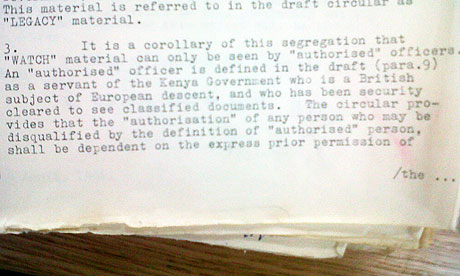
Painstaking measures were taken to prevent post-independence
governments from learning that the watch files had ever existed. One
instruction states: "The legacy files must leave no reference to watch
material. Indeed, the very existence of the watch series, though it may
be guessed at, should never be revealed."
When a single watch file was to be removed from a group of legacy files, a "twin file" – or dummy – was to be created to insert in its place. If this was not practicable, the documents were to be removed en masse. There was concern that Macleod's directions should not be divulged – "there is of course the risk of embarrassment should the circular be compromised" – and officials taking part in the purge were even warned to keep their W stamps in a safe place.
Many of the watch files ended up at Hanslope Park. They came from 37 different former colonies, and filled 200 metres of shelving. But it is becoming clear that much of the most damning material was probably destroyed. Officials in some colonies, such as Kenya, were told that there should be a presumption in favour of disposal of documents rather than removal to the UK – "emphasis is placed upon destruction" – and that no trace of either the documents or their incineration should remain. When documents were burned, "the waste should be reduced to ash and the ashes broken up".
Some idea of the scale of the operation and the amount of documents that were erased from history can be gleaned from a handful of instruction documents that survived the purge. In certain circumstances, colonial officials in Kenya were informed, "it is permissible, as an alternative to destruction by fire, for documents to be packed in weighted crates and dumped in very deep and current-free water at maximum practicable distance from the coast".
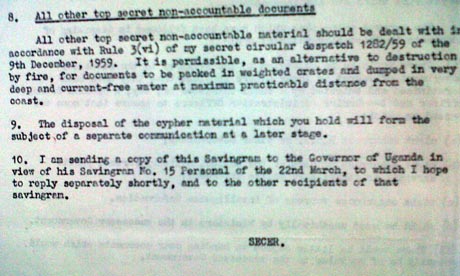
When a single watch file was to be removed from a group of legacy files, a "twin file" – or dummy – was to be created to insert in its place. If this was not practicable, the documents were to be removed en masse. There was concern that Macleod's directions should not be divulged – "there is of course the risk of embarrassment should the circular be compromised" – and officials taking part in the purge were even warned to keep their W stamps in a safe place.
Many of the watch files ended up at Hanslope Park. They came from 37 different former colonies, and filled 200 metres of shelving. But it is becoming clear that much of the most damning material was probably destroyed. Officials in some colonies, such as Kenya, were told that there should be a presumption in favour of disposal of documents rather than removal to the UK – "emphasis is placed upon destruction" – and that no trace of either the documents or their incineration should remain. When documents were burned, "the waste should be reduced to ash and the ashes broken up".
Some idea of the scale of the operation and the amount of documents that were erased from history can be gleaned from a handful of instruction documents that survived the purge. In certain circumstances, colonial officials in Kenya were informed, "it is permissible, as an alternative to destruction by fire, for documents to be packed in weighted crates and dumped in very deep and current-free water at maximum practicable distance from the coast".

Documents that survive from Malaya suggest a far more haphazard destruction process, with relatively junior officials being permitted to decide what should be burned and what should be sent to London.
Dr Ed Hampshire, diplomatic and colonial record specialist at the National Archive, said the 1,200 files so far transferred from Hanslope Park represented "gold dust" for historians, with the occasional nugget, rather than a haul that calls for instant reinterpretation of history. However, only one sixth of the secret archive has so far been transferred. The remainder are expected to be at Kew by the end of 2013.
Sunday, April 15, 2012
The White Star Line: in a class of its own
 |
| Image from the Titanic Letterpress blog |
The class differences on board the RMS Titanic have been pointed out before. Hell, even the movie Titanic focuses on this feature. But a little known letter that surfaced a few years back highlights the typical relationship between the RMS Titanic's management and their employees.
In 2008, a letter sent to Alexander Littlejohn—steward on board the RMS Titanic—from the White Star Line shipping company, was up for auction. The letter was sent as soon as news of the ship's sinking reached the company. While survivors were still struggling in the icy seas, the White Star Line 'sacked' all of its employees in order to save paying thousands in wages to survivors. Staff like Littlejohn, who were struggling to paddle life rafts of 'posh first-class ladies', were said in the letter to have 'disembarked on the high seas' on 15 April 1912—the day the ship hit an iceberg and sank with 1,500 people. 'Disembarked' was a polite company term to describe being thrown into the icy Atlantic.
In an ironic twist, the letter—designed to avoid paying out any money to the surviving workers—was valued at over £1m.
With all the hype today on the Titanic, I think it's important to recognise alternative narratives around this disaster, and remember its class element.
Titanic Letterpress...

With all the Titanic hype this week, there's even a book/blog about the Titanic's in-house printshop. Interesting revived typeface, but I like the linocuts the best... have a peek here.
Thursday, April 5, 2012
Elizabeth Catlett (1915-2012)
From Icky at Justseeds: I just learned that Elizabeth Catlett died on Monday, at her home in Mexico at the age of 96. Catlett was an outstanding participant of the black arts movement in the US, as well as an early (and long time) member of the Taller de Grafica Popular in her adopted home in Mexico. She was a sculptress and a print-maker; and her masterful synthesis of line, form, and content exerted a huge influence on folks around the world, and especially on many of us involved in Justseeds. RIP
Wednesday, April 4, 2012
Celebrate People’s History, an exhibition of over 50 international posters documenting radical moments in history
Katipo Books is proud to present Celebrate People’s History - an exhibition of over 50 international posters documenting radical moments in history. The exhibition will run from Monday 16 April until Monday 14 May in the Young Adults section of the Upper Riccarton Community and School Library.
Since 1998 the Celebrate People’s History Project has produced an amazing array of political posters by different artists from around the world, each highlighting a historical example of struggle for human rights, social justice, and freedom. From the Spanish Revolution to feminist labour organisers, indigenous movements to environmental sustainability, protests against racism to the Korean Peasant’s League — Celebrate People’s History canvases global movements in collaboration with a global network of artists.
Visually the posters are as diverse as the topics themselves. Screenprint, woodcut, linocut, illustration, line art and traditional graphic design all feature in full colour — employed to engage in much needed critical reflection about aspects of our history often overlooked by mainstream narratives. A seamless welding of art and social themes, Celebrate People’s History is sure to excite the history junkie, poster enthusiast, art student, adult learner, and activist alike.
There will also be a public talk on Saturday 21 April by local poster maker/historian Jared Davidson on his own contribution to the exhibition with the poster, Red Feds: the first and only People’s History poster about New Zealand.
Celebrate People's History
Monday April 16 - May 14, 2012
Open during normal library hours
- Monday - Friday 9:00 am - 8:00 pm
- Saturday & Sunday 10:00 am - 4:00 pm
Upper Riccarton Library (Young Adult Section)
71 Main South Road, Sockburn

Tuesday, April 3, 2012
Labour History Project Newsletter 54: sneak peek
Here's a sneak peek at the cover of the latest Labour History Project Newsletter, featuring Miss Elsie Thorn of Christchurch dressed as the Maoriland Worker, 1911. Once again, it was a fun wee design job, and now that I have a grid it's a really quick job at that. Check out the LHP and past newsletters here.
Saturday, March 31, 2012
Pic of batch #1, and bottling #3: American Pale Ale
 |
| #1: Coopers Real Ale |
Well, a quick beer update. Tried Batch #2—the Black Rock Pilsner—this week, which is close to 4 weeks old now. It's still a little young I think, but it has come out as a super drinkable, refreshing Pilsner. It's got a bit more depth than the Batch #1 thanks to the Copper Tun enhancer, but still not as hoppy as I'd like (think Wigram Bohemian Pilsner, or the Three Boys Pilsner). This may change over time, but I definitely think the addition of some Riwaka or Tettnanger Hops would do the trick. Also, Batch #1—the Cooper's Real Ale—is heaps better now that it is 8 weeks old. The sugar taste is still there, but its flavorsome and quite nice. The picture above is of the Coopers Real Ale.
Today my friend and I bottled Batch #3, which will hopefully be close to an APA (American Pale Ale)—a hoppy, aromatic ale that's bitter, but not quite as bitter as an IPA. Here's a run down of the ingredients, and a few pics to boot.
Batch #3: American Pale Ale (APA)
Method: Kit + Enhancer + Hops
Ingredients: Muntons Traditional Bitter Kit (35-45 EBU, 27-33 EBC), Copper Tun English Bitter Enhancer, Golding Hops (0.5oz pellets as a tea), Chinook Hops (1oz pellets, dry hopped)
Original Gravity: ???
Final Gravity: 1020
ABV: ???
Bottles: Glass (500ml, 330ml).
Bottled: 31-03-2012
Grabbed the Muntons Traditional Bitter Kit, which had one of the higher bitter ratings off the shelf, and spiced things up with 2 varieties of hops (in pellet form). Using a pre-boiled and sanitised stocking, I boiled 0.5oz of Golding Hops in 3L of water, making a really aromatic hop tea (this method won't get any bitterness from the hops, just flavour and aroma). This replaced the hot water I usually use from the kettle. We then added the Copper Tun Enhancer, stirred well, and poured in cold water to make 22L at 22 degrees. It smelt awesome, and the kit was nice and bitter—more so than the last two kits.
Now here's were we made a mistake. We didn't stir the cold water into the hot, which meant that when I took a hydrometer reading it was only at 1030. We did gently stir and swish around the yeast, but yeah, the density of the mix was really uneven. When I took a reading from the tap, it was over 1090 (eek!). Note to self: stir before adding the yeast to aerate properly.
Four days later, I bagged 1oz of Chinook Hop pellets in a sanitised stocking and placed them into the fermenter. This will hopefully add more complexity to the flavour and aroma, and give it that APA touch.
Which leads to today's bottling. We had a sneaky taste of the beer, and wow! Nice and bitter, and smelt awesome. Obviously still pretty green, very opaque still (a light brown/mud colour), but that will change over time. Like the last batch, it never passed 1020. I wonder if this is from not stirring, or maybe I need some more fermentables as the Enhancer isn't enough. But apart from that, I'm really excited about this one.
Subscribe to:
Comments (Atom)
































